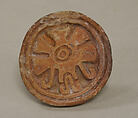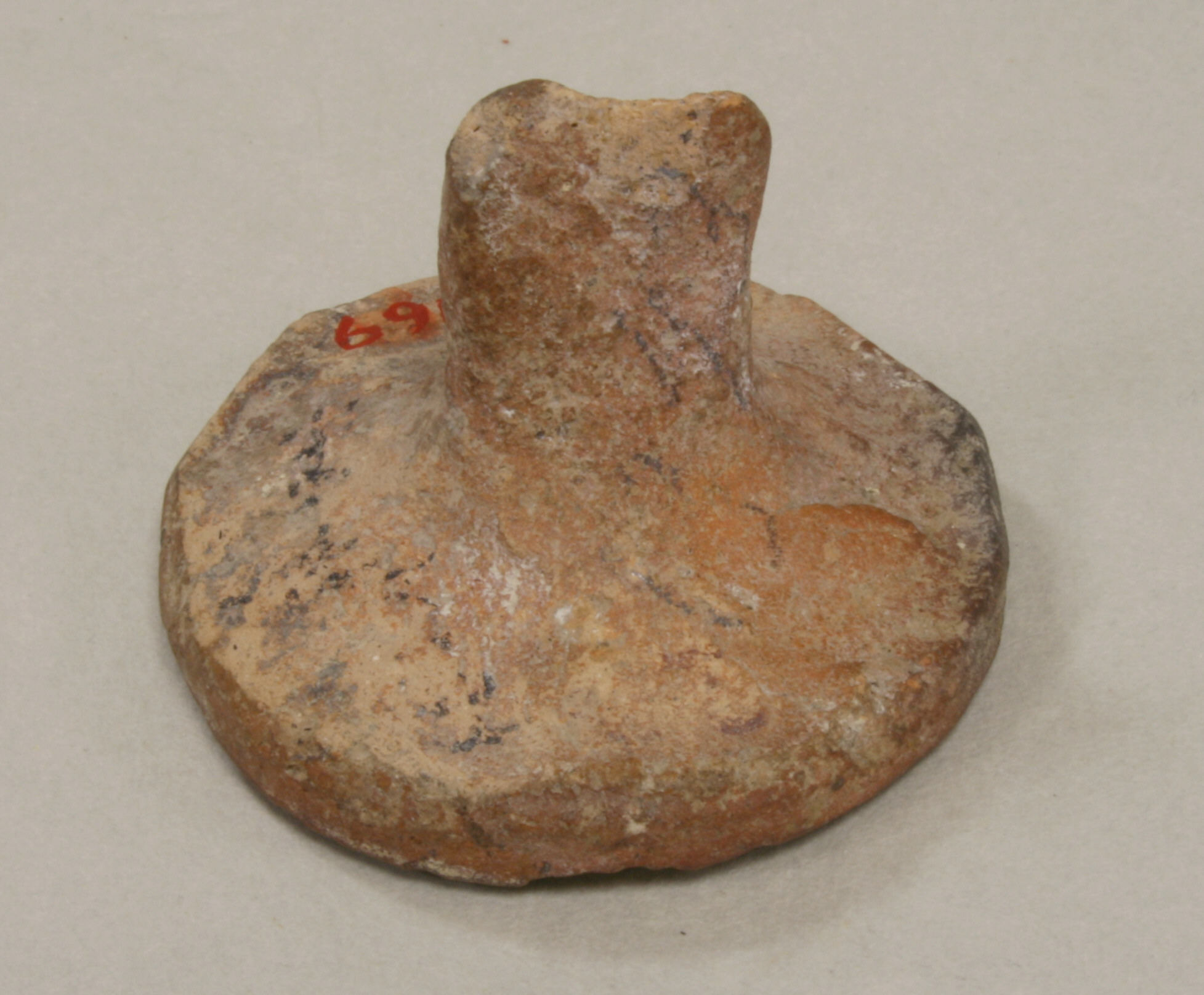Stamp, Butterfly
Not on view
This ceramic stamp features the image of a butterfly depicted from a dorsal view with outstretched wings, frontal legs, and proboscis. Contained by a double-banded, circular border, the butterfly bears another circle on its abdomen or back. The latter motif likely signifies a rounded jade bead (chalchihuitl), which is equated in the Nahuatl language with the color green, fertility, and preciousness.
Butterfly imagery enjoyed a long history in the arts of Mesoamerica and probably had multiple meanings and associations through time. In the Early Classic murals at Teotihuacan and Cholula, they are associated with warriors, fire, fertility, death, and rebirth. Among the Mixtecs and Aztecs of the Late Postclassic period (ca. 1300–1521), they adorn nosepieces and colorful feasting vessels as well as the sculptures of both male and female gods. As companions to Xochiquetzal ("Flower Queztal") and Xochipilli ("Flower Prince"), they represent the themes of pleasure and abundance; yet with Itzpapalotl ("Obsidian Butterfly"), ravenous hunger and duplicity. Nevertheless, most scholars agree that Mesoamericans regarded butterflies as something akin to the soul—a belief that was also shared by the ancient Greeks and Hindus. Often found adorning ceramic incense burners—and typically appearing in funerary contexts—their associations with fire, regeneration, and respiration are clear. Furthermore, butterflies, along with hummingbirds and other winged beings, were closely related to concepts of reincarnation.
On a metaphorical level, the inclusion of stamps with the dead may refer to ideas of ephemerality as expressed in Aztec poetry. After all, in their narrow capacity as objects of embellishment, stamps are solely used to adorn surfaces—all of which are diaphanous (e.g., cloth), breakable (e.g., ceramic), and otherwise perishable. Therefore, by decorating their own skins with these same stamps, the Aztecs may have conceptually aligned (or equated) the human form with the fragility of fabric and clay. Regardless, these objects were fundamentally very personal possessions that were associated closely with the body, both living and dead.
William T. Gassaway, 2014-15 Sylvan C. Coleman and Pamela Coleman Fellow
-----
Resources and Additional Reading
Berlo, Janet C. "The Warrior and the Butterfly: Central Mexican Ideologies of Sacred Warfare and Teotihuacan Iconography." In Text and Image in Pre-Columbian Art, edited by Janet C. Berlo, pp. 79–117. BAR International Series 180. Oxford: Oxford University Press, 1983.
Beutelspacher, Carlos R. Las mariposas entre los antiguos mexicanos. México: Fondo de Cultura Económica, 1988.
Houston, Stephen, and Karl Taube. "An Archaeology of the Senses: Perception and Cultural Expression in Ancient Mesoamerica." Cambridge Archaeological Journal 10, no. 2 (2000), pp. 261–94.
Pasztory, Esther. The Murals of Tepantitla, Teotihuacan. New York: Garland Publishing Inc., 1976. Concerning the meaning and appearance of butterfly imagery, see p. 157.
Peterson, Jeanette Favrot. The Paradise Garden Murals of Malinalco: Utopia and Empire in Sixteenth-Century Mexico. Austin: University of Texas Press, 1993. Concerning the meaning and appearance of the ilhuitl sign, see pp. 47–50.
Taube, Karl. Olmec Art at Dumbarton Oaks. Washington, D.C.: Dumbarton Oaks Research Library and Collection, 2004. Regarding the meaning of jade, see pp. 203–217.
Due to rights restrictions, this image cannot be enlarged, viewed at full screen, or downloaded.
This artwork is meant to be viewed from right to left. Scroll left to view more.



